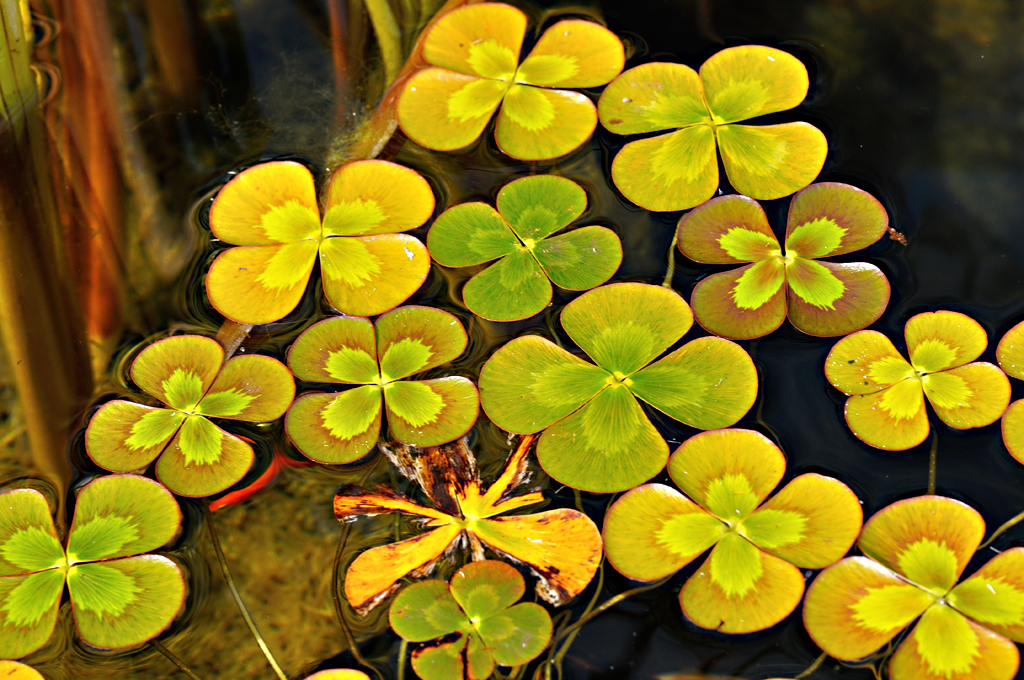Marsilea
|
Family: Marsileaceae |
Plants aquatic or amphibious, forming diffuse or dense colonies. Roots arising at nodes, sometimes also on internodes. Leaves deciduous in temperate regions, heteromorphic, floating leaves averaging larger than land leaves. Petiole filiform, stiffly erect or procumbent in land leaves, lax in floating leaves. Blade palmately divided into 4 pinnae. Pinnae cuneate or obdeltate, pulvinate at base, frequently with numerous red or brown streaks abaxially in floating leaves. Sporocarps borne on branched or unbranched stalks at or near bases of petioles, aboveground (except in Marsilea ancylopoda ), attached laterally to stalk apex (attached portion called raphe), tip of stalk often protruding as bump or tooth (proximal tooth), some species also with tooth distal to stalk apex (distal tooth); sporocarps densely to sparsely hairy, less so with age, dehiscing into 2 valves. Species identification is virtually impossible without fertile material. The common name water-clover refers to the resemblance of the leaves to those of clover ( Trifolium spp., Fabaceae); pepperwort refers to the sporocarp, which approximates a peppercorn in size and shape.
PLANT: Colonial aquatic perennial herbs. PETIOLES: slender, lax in floating-leaved forms. LEAFLETS: 4, wedge-shaped, sometimes with narrow brown or reddish brown lines or streaks along the veins. SPOROCARPS: positioned aboveground (rarely subterranean elsewhere), oblong-oval to ovate or quadrangular in outline, flattened, attached laterally to the stalk tip, the stalk tip often extended past the attachment point as a low tubercle or tooth, in some species a second tooth produced along the acroscopic portion of the rim distal to the stalk tip, the surface with evident venation, tan to grayish brown or dark brown at maturity, dehiscing into 2 valves. X = 20. NOTES: Ca. 45 spp., nearly worldwide. (for Luigi Marsigli, Italian mycologist). The sporocarps of Marsilea species, which have a long fossil history, also are extremely long-lived. Samples from century-old herbarium specimens have been germinated successfully in the laboratory. The life cycle is also completed extremely quickly (most ferns require several months), perhaps as an adaptation to fluctuating water levels, and less than a week usually is necessary following sporocarp germination for fertilization and the subsequent generation of new sporophytes. Sporocarps are required for most species determinations in Marsilea. In the Arizona species, these tend to be produced only during the under collected “terrestrial phase” when plants stranded by receding waterlines produce stems with relatively closely spaced nodes and short-petiolate leaves. Thus, the distributions of the two species present in Arizona are not fully understood. REFERENCES: Windham, M. D. and G. Yatskievych. 2009. Vascular Plants of Arizona: Marsileaceae. CANOTIA 5 (1): 30-33. Lvs long-petiolate, the blade mostly floating or emergent, with 4 approximate lfls (2 juxtaposed pairs) regularly spreading from the petiole-tip and suggesting a 4-lvd clover; lfls dichotomously and reticulately veined, and with an intramarginal connecting vein; sporocarp longitudinally ±bilocular and with many transverse partitions, finally dehiscent by 2 valves, somewhat compressed, ±ovate or elliptic, in many spp. (including ours) attached laterally to the distal part of the peduncle, which forms a raphe that may project as an "inferior" tooth; a "superior" tooth often also present on the upper side of the sporocarp a little above the base; sori several or many, each with central megasporangia and lateral microsporangia on an elongate receptacle. 45, cosmop. Gleason, Henry A. & Cronquist, Arthur J. 1991. Manual of vascular plants of northeastern United States and adjacent Canada. lxxv + 910 pp. ©The New York Botanical Garden. All rights reserved. Used by permission. |

